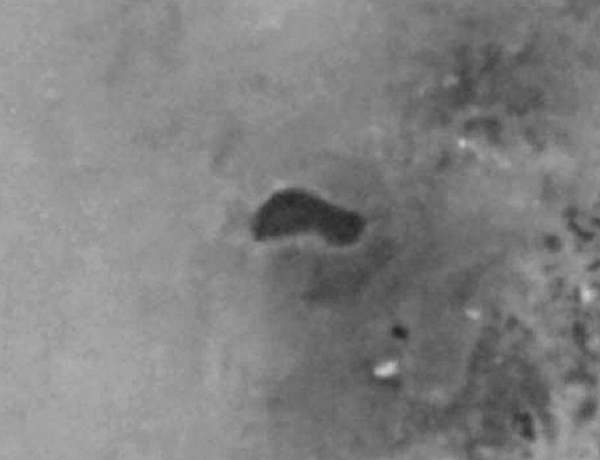
The dark spot in the middle of this image is Ontario Lacus, possibly a shallow lake filled with liquid methane located near the south pole of Titan, imaged with synthetic-aperture radar by Cassini.
Ontario Lacus on Titan covers about 5,800 square miles in area—about four-fifths the size of Lake Ontario here on Earth.Radar images do not work like visible light photos; instead, they indicate rugged, irregular terrain as light areas and smoother, highly-reflective areas as dark. The lake shows up as a dark area, having a smooth surface highly reflective to radar. The visual translations of radar imagery seem to indicate lake-shaped structure to the dark areas, nearly identical to lakes on Earth.
The difference here though, at least in Ontario Lacus’ instance, is that there seems to be no surface movement at all in the lake. The radar data shows less than a 3mm variance in the surface….it’s literally as smooth as glass.
“Unless you actually poured concrete and spread it really, really smoothly, you’d never see something like that on Earth.” – Howard Zebker, Stanford University
Although the weather this time of year on Titan’s south pole is expected to be calm, a body of liquid as large as Lake Victoria would logically have some wave motion in it. In fact, due to the gravity and the estimated viscosity of liquid hydrocarbons, waves on Titan have been computer-modeled to be seven times as high and long as they would be on Earth under similar conditions. Yet the Ontario Lacus data shows almost no height variance at all, leaving researchers puzzled. Could the liquid methane be just that thick, and smoothed over like tar? Or is it impervious to whatever wind is present (or absent) on Titan? Since the exact behavioral properties of large bodies of cold liquid methane aren’t yet known, it’s hard to say.
Alternatively Ontario Lacus could be an ephemeral “dry” lake, which fills only occasionally based on seasonal variations in Titan’s climate.
Stanford University researcher Howard Zebker says the only way to know for certain is to “have your next probe plunk down in the middle of a lake. Anything else is an indirect measurement and some kind of a model.”
Titan is the only other world in our solar system found to have an active weather cycle, where liquids from the surface evaporate into the atmosphere, form clouds, and return to the surface as precipitation. But instead of being water-based, like here on Earth, the process operates in extremely cold conditions and ethane and methane serve as the liquid.
Read more at NewScientist.com.
Image: NASA/JPL/Space Science Institute